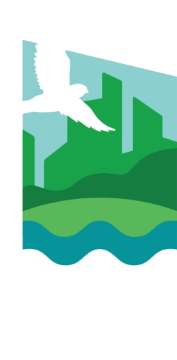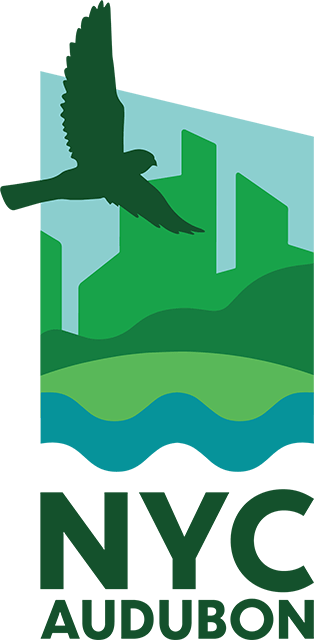A More Diverse and Equitable Future for Conservation
Equity, diversity, inclusion, and accessibility (EDIA) is a central pillar of NYC Audubon’s 2020-2025 strategic plan. The more people who hear our message and help us help bird populations, the better. The protection of birds depends on work and support across all of the City’s communities.
The organization has worked consistently to center EDIA in our conservation, engagement, and advocacy efforts; in our communications and outreach; in our board governance; and in our internal operations. We are proud to share some highlights.
Engaging All New Yorkers with Birds and Nature
We believe that birding and nature are for everyone! We've been working hard to make our programs and resources more accessible, inclusive, and welcoming to the many different communities and people of New York City:

A free bird outing led by Gabriel Willow in Central Park. Photo: NYC Audubon
Removing financial barriers to program participation
We are committed to making two-thirds of our 300 annual public programs free. In 2023, 80% of our guided bird outings were free.
_crop.jpg)
New guide Woo Sung Park leads participants on a bird tour in the New York Botanical Garden. Photo: Tank Brain Productions
.jpg)
The cover of Las Aves de la Ciudad de Nueva York, set for publication in spring 2023. Reinita de Manglar/Yellow Warbler photo: César A. Castillo
Expanding our language offerings
We are now offering multilingual classes and bird outings, and this spring, NYC Audubon published the City's first bilingual Spanish-English field guide. Las Aves de la Ciudad de Nueva York/The Birds of New York City, by Dr. Adam Moreno and NYC Audubon was adapted from Moreno's previous work, a guide to the birds of Providence, RI.
Lea más sobre la guía de campo aquí. / Read more about the field guide.
Lea más sobre la guía de campo aquí. / Read more about the field guide.
.jpg)
Map of birding hotspots accessible by public transportation. Map courtesy of Metropolitan Transit Authority
No car, no problem
We are highlighting the many birding hotspots around the City accessible by public transportation, with our popular Birding By Subway brochure, first published in 2013.
We are highlighting the many birding hotspots around the City accessible by public transportation, with our popular Birding By Subway brochure, first published in 2013.

Mourning Doves. Photo: Carol Hamilton/Getty Images
Making birding accessible for all
Our communications and program planning places an emphasis on physical accessibility, including hosting our first Bird Sit in Spring 2023.
Our communications and program planning places an emphasis on physical accessibility, including hosting our first Bird Sit in Spring 2023.
Creating Welcoming Spaces for Birders of all Backgrounds
Nature should be a place where everyone feels welcome. NYC Audubon works to celebrate the diversity of birders that make our community special:
.jpg)
Young Conservationist outing in Central Park, May 2022. Photo: NYC Audubon
The Young Conservationist Group
In 2021, we launched a new group for birders ages 18-35, which now has 125 members. The group is guided by a Young Conservationist Council that is creating and connecting a community of younger bird enthusiasts and conservation advocates. Become a Young Conservationist member and join the fun!
In 2021, we launched a new group for birders ages 18-35, which now has 125 members. The group is guided by a Young Conservationist Council that is creating and connecting a community of younger bird enthusiasts and conservation advocates. Become a Young Conservationist member and join the fun!
.jpg)
Let’s Go Birding Together outing in Central Park, June 2022. Photo: NYC Audubon
Let’s Go Birding Together
Every year in celebration of Pride Month, we host a series of “Let’s Go Birding Together” outings around the City.
Every year in celebration of Pride Month, we host a series of “Let’s Go Birding Together” outings around the City.
.jpg)
#BlackBirdersWeek outing in Central Park with Chris Cooper, June 2021. Photo: NYC Audubon
#BlackBirdersWeek
We participate in and host #BlackBirdersWeek events each spring in June. BlackBirdersWeek is organized by the BlackAFInSTEM Collective, which “seeks to support, uplift, and amplify Black Science, Technology, Engineering, and Mathematics professionals in natural resources and the environment through professional development, career connection, and community engagement.”
We participate in and host #BlackBirdersWeek events each spring in June. BlackBirdersWeek is organized by the BlackAFInSTEM Collective, which “seeks to support, uplift, and amplify Black Science, Technology, Engineering, and Mathematics professionals in natural resources and the environment through professional development, career connection, and community engagement.”
.jpg)
Graphic: Fund for Public Housing
NYCHA in Nature Program
A new program launched in spring 2023 in partnership with the Fund for Public Housing offers opportunities to bird and enjoy nature for residents of New York City Housing Authority public housing and invites the general public to explore urban biodiversity on open spaces within NYCHA campuses and in adjacent parks.
A new program launched in spring 2023 in partnership with the Fund for Public Housing offers opportunities to bird and enjoy nature for residents of New York City Housing Authority public housing and invites the general public to explore urban biodiversity on open spaces within NYCHA campuses and in adjacent parks.
We welcome your feedback! Let us know how we can improve inclusivity and accessibility for our public programs. Contact us at programs@nycaudubon.org.
.jpg)
Protecting Urban Biodiversity
NYC Audubon works to make the City a more sustainable place for birds and people. Our focus on protecting urban biodiversity can be seen in our work from the rooftops of Manhattan and industrial parts of Brooklyn, to the beaches of the Rockaways and the habitat along the Bronx River.
Through our partnership with Madison Square Park Conservancy, we are monitoring the park’s bird use and expanding public programs to engage human visitors in this small urban green space. Our work will be used to understand and emphasize the conservation and engagement value of small parks in the City.
We’ve recently launched a new project that aims to measure the impact of restoring nature along the very urban Bronx River. We are excited to partner with the Bronx River Alliance to track how wading birds have responded to the improved habitats created by the Alliance’s recent restoration efforts. By comparing these new findings with the data we collected before the restoration, we hope to measure how urban conservation efforts like these benefit both people and wildlife.
.jpg)
A group of students gather around the bird fountain atop Kingsland Wildflowers at Broadway Stages. Photo: Newtown Creek Alliance
Urban Green Roofs
A top conservation priority for NYC Audubon is expanding the City’s green roofs, especially in low-income neighborhoods where they can provide important environmental and economic benefits for both people and wildlife. Green roofs can reduce the heat island effect and improve air quality—both of which are problems in low-income neighborhoods that typically have fewer trees and green spaces—by absorbing and filtering heat and pollutants.
NYC Audubon founded and coordinates the Green Roof Researchers Alliance, a powerful consortium of researchers, practitioners, and advocates who have furthered important legislation including the 2019 passage of the City’s Local Laws 92 and 94, which require that all new buildings or roof replacements have green roofs and/or solar panels, and a new and improved tax abatement that prioritizes vulnerable areas in New York City.
NYC Audubon founded and coordinates the Green Roof Researchers Alliance, a powerful consortium of researchers, practitioners, and advocates who have furthered important legislation including the 2019 passage of the City’s Local Laws 92 and 94, which require that all new buildings or roof replacements have green roofs and/or solar panels, and a new and improved tax abatement that prioritizes vulnerable areas in New York City.
The seven-acre Javits Center network of green roofs, the largest in New York City, can absorb up to seven million gallons of stormwater runoff each year and reduce the Javits Center’s energy consumption by 26%. For a decade, the Javits Center has welcomed NYC Audubon’s ongoing monitoring research.
Beginning in 2016, NYC Audubon partnered with Newtown Creek Alliance, Broadway Stages, and Alive Structures to create a series of green roofs at Kingsland Wildflowers in Greenpoint, Brooklyn. Located in a polluted industrial area next to Newtown Creek, these roofs soak up stormwater, clean and cool the air, save energy costs, and provide much-needed habitat for birds, bats, and insects.
.jpg)
Advocacy and Engagement Associate Jesse McLaughlin and Public Programs Manager Roslyn Rivas at Battery Park outreach event. Photo: NYC Audubon
Staffing and Leadership
We’ve worked to center EDIA in our governance and internal operations, to match our work in our mission-based programs. Our strategic plan makes a commitment to having people of color or other under-represented groups make up at least 50% of the board by 2025 (we are currently at 40%). We actively recruit staff who will bring different perspectives and backgrounds to our work, and to ensure that our programs reflect the communities we serve.
.jpg)
NYC Audubon is changing its name, though our work and mission remain the same.
A Name Change
Names and brands can be a visual symbol of an organization’s values, and symbols matter. In March 2023, the NYC Audubon board of directors voted to change its name, dropping ‘Audubon’ from its moniker. After a thorough assessment process, we decided that John James Audubon’s legacy presents a barrier to people who might otherwise become involved in or support our work. We will be undertaking a process to develop a new name that represents what we do, embodies our organizational values, and is inclusive and welcoming to all New Yorkers. Learn more about our decision here.
Statement on Equity, Diversity, Inclusion, and Accessibility (adopted by NYC Audubon’s board of directors in 2018)
New York City Audubon believes all people have the right to a close connection to the natural world and the right to a healthy environment. Preserving our environment is only possible if we all feel that connection.
We recognize that inequities in our society are widespread and hinder access to nature. Only by embracing equity, diversity, inclusion, and accessibility as values and striving for them in practice will we begin to foster a love of nature in all people and inspire them to be active stewards of the environment.
We further believe that to thrive as an organization and effectively advance our mission and vision, the diversity of New York City’s people must be represented in, and welcomed into, our leadership, staff, and membership. The expertise, values, and perspectives of a diverse and inclusive organization are fundamental to expanding the reach and impact of our conservation, advocacy, and educational efforts.
We commit to building an equitable, diverse, inclusive, and accessible New York City Audubon, dedicated to protecting nature for all of New York City’s people and its wild birds.
Let us know what you think
We know these efforts are just the start. We welcome your feedback and partnership on including equity, diversity, accessibility, and inclusion in our work. Please let us know what you think at feedback@nycaudubon.org.


